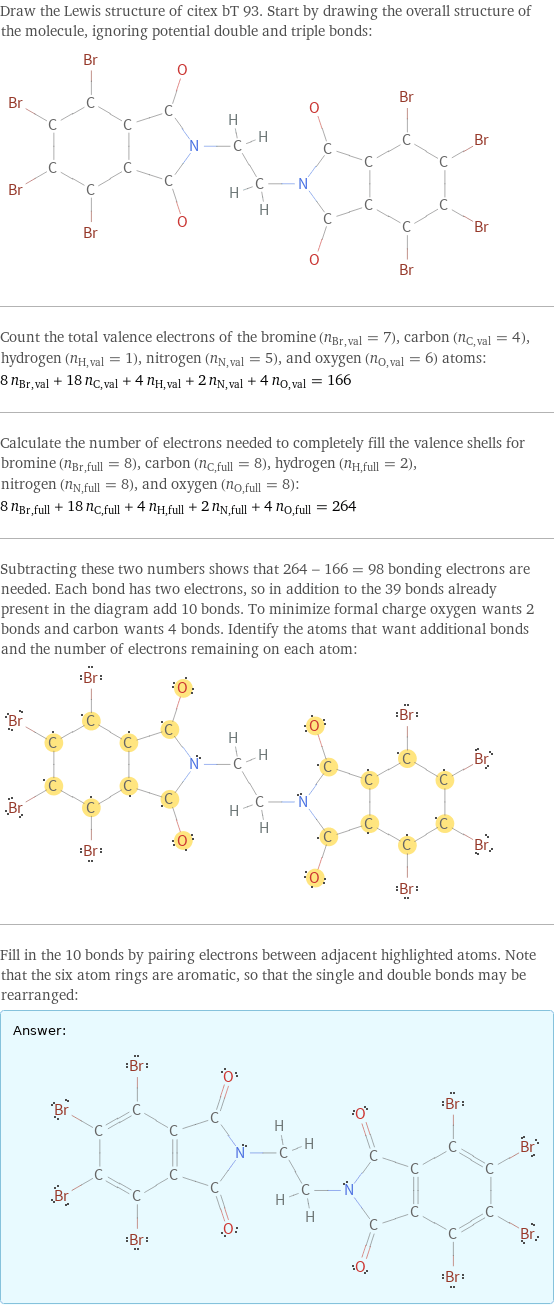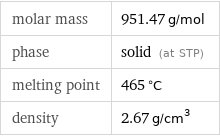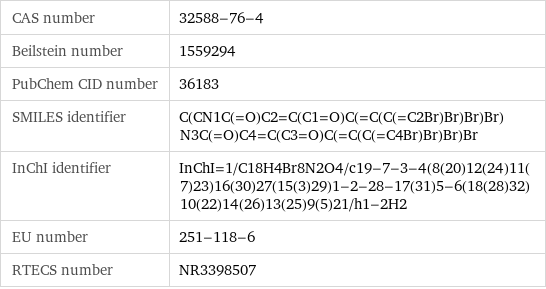Input interpretation

citex bT 93
Chemical names and formulas
![formula | C_18H_4Br_8N_2O_4 name | citex bT 93 IUPAC name | 4, 5, 6, 7-tetrabromo-2-[2-(4, 5, 6, 7-tetrabromo-1, 3-dioxo-isoindol-2-yl)ethyl]isoindole-1, 3-dione alternate names | ethylene bis(tetrabromophthalimide) mass fractions | Br (bromine) 67.2% | C (carbon) 22.7% | H (hydrogen) 0.424% | N (nitrogen) 2.94% | O (oxygen) 6.73%](../image_source/ec723006619ed0063595ce6d38fdf1d2.png)
formula | C_18H_4Br_8N_2O_4 name | citex bT 93 IUPAC name | 4, 5, 6, 7-tetrabromo-2-[2-(4, 5, 6, 7-tetrabromo-1, 3-dioxo-isoindol-2-yl)ethyl]isoindole-1, 3-dione alternate names | ethylene bis(tetrabromophthalimide) mass fractions | Br (bromine) 67.2% | C (carbon) 22.7% | H (hydrogen) 0.424% | N (nitrogen) 2.94% | O (oxygen) 6.73%
Lewis structure

Draw the Lewis structure of citex bT 93. Start by drawing the overall structure of the molecule, ignoring potential double and triple bonds: Count the total valence electrons of the bromine (n_Br, val = 7), carbon (n_C, val = 4), hydrogen (n_H, val = 1), nitrogen (n_N, val = 5), and oxygen (n_O, val = 6) atoms: 8 n_Br, val + 18 n_C, val + 4 n_H, val + 2 n_N, val + 4 n_O, val = 166 Calculate the number of electrons needed to completely fill the valence shells for bromine (n_Br, full = 8), carbon (n_C, full = 8), hydrogen (n_H, full = 2), nitrogen (n_N, full = 8), and oxygen (n_O, full = 8): 8 n_Br, full + 18 n_C, full + 4 n_H, full + 2 n_N, full + 4 n_O, full = 264 Subtracting these two numbers shows that 264 - 166 = 98 bonding electrons are needed. Each bond has two electrons, so in addition to the 39 bonds already present in the diagram add 10 bonds. To minimize formal charge oxygen wants 2 bonds and carbon wants 4 bonds. Identify the atoms that want additional bonds and the number of electrons remaining on each atom: Fill in the 10 bonds by pairing electrons between adjacent highlighted atoms. Note that the six atom rings are aromatic, so that the single and double bonds may be rearranged: Answer: | |
3D structure

3D structure
Basic properties

molar mass | 951.47 g/mol phase | solid (at STP) melting point | 465 °C density | 2.67 g/cm^3
Units

Solid properties (at STP)

density | 2.67 g/cm^3
Units

Chemical identifiers

CAS number | 32588-76-4 Beilstein number | 1559294 PubChem CID number | 36183 SMILES identifier | C(CN1C(=O)C2=C(C1=O)C(=C(C(=C2Br)Br)Br)Br)N3C(=O)C4=C(C3=O)C(=C(C(=C4Br)Br)Br)Br InChI identifier | InChI=1/C18H4Br8N2O4/c19-7-3-4(8(20)12(24)11(7)23)16(30)27(15(3)29)1-2-28-17(31)5-6(18(28)32)10(22)14(26)13(25)9(5)21/h1-2H2 EU number | 251-118-6 RTECS number | NR3398507
Toxicity properties

RTECS classes | primary irritant